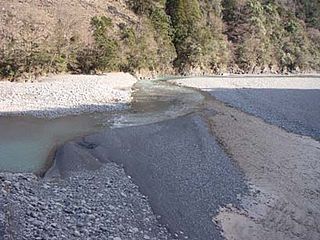
Hydroelectricity is electricity produced from hydropower. In 2015, hydropower generated 16.6% of the world's total electricity and 70% of all renewable electricity, and was expected to increase about 3.1% each year for the next 25 years.
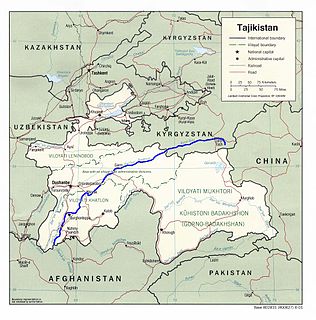
The Vakhsh (River), also known as the Surkhob (Сурхоб), in north-central Tajikistan, and the Kyzyl-Suu, in Kyrgyzstan, is a Central Asian river, and one of the main rivers of Tajikistan. It is a tributary of the Amu Darya river.

The Gandhi Sagar Dam is one of the four major dams built on India's Chambal River. The dam is located in the Mandsaur, Neemuch districts of the state of Madhya Pradesh. It is a masonry gravity dam, standing 62.17 metres (204.0 ft) high, with a gross storage capacity of 7.322 billion cubic metres from a catchment area of 22,584 km2 (8,720 sq mi). The dam's foundation stone was laid by Prime Minister of India Pandit Jawaharlal Nehru on 7 March 1954, and construction of the main dam was done by leading contractor Dwarka Das Agrawal & Associates and was completed in 1960. Additional dam structures were completed downstream in the 1970s.
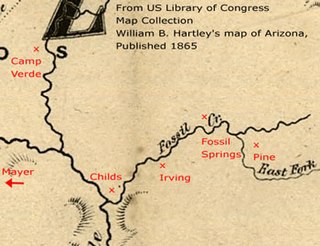
Childs-Irving Hydroelectric Facilities consisted of two 20th-century power plants, a dam, and related infrastructure along or near Fossil Creek in the U.S. state of Arizona. The complex was named an Historic Mechanical Engineering Landmark in 1971 and was added to the National Register of Historic Places 20 years later. Decommissioned in 2005, the plants no longer produce electricity, and much of the infrastructure—including the dam, the Irving Power Plant, and thousands of feet of concrete flumes—have been removed, and the creek's original flow has been restored.
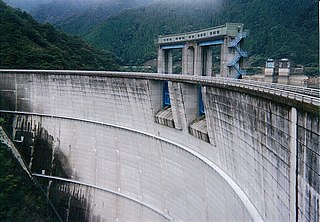
The Shintoyone Dam (新豊根ダム) is a multipurpose dam in the village of Toyone in the Aichi Prefecture of Japan.

The Shiroyama Dam is a multi-purpose dam on the main stream Sagami River in Sagamihara, Kanagawa Prefecture on the island of Honshū, Japan.

The Tashiro Dam is a dam on the Ōi River in Aoi-ku, Shizuoka, Shizuoka Prefecture on the island of Honshū, Japan. It was the first concrete gravity dam to be constructed on the Ōi River, and has a hydroelectric power generating station owned by the Tokyo Electric Power Company.

The Ōigawa Dam is a dam on the Ōi River in Haibara District, Kawanehon, Shizuoka Prefecture on the island of Honshū, Japan. It has a hydroelectric power generating station owned by the Chubu Electric Power Company.
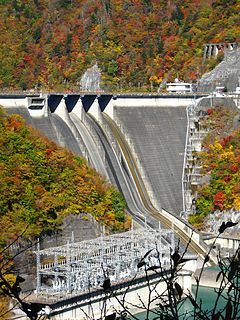
The Hatanagi-I is a dam on the Ōi River in Aoi-ku, Shizuoka, Shizuoka Prefecture on the island of Honshū, Japan. With a height of 125 metres (410 ft), it is the tallest hollow-core concrete gravity dam in the world. It has a hydroelectric power generating station owned by the Chubu Electric Power Company. It supports a 137 megawatts (184,000 hp) pumped-storage hydroelectric power station.

The Hatanagi-II is a dam on the Ōi River in Aoi-ku, Shizuoka, Shizuoka Prefecture on the island of Honshū, Japan. A hollow-core concrete gravity dam, it has a hydroelectric power generating station owned by the Chubu Electric Power Company.

The Ikawa Dam is a dam on the Ōi River in Aoi-ku, Shizuoka, Shizuoka Prefecture on the island of Honshū, Japan. It was the first hollow core concrete gravity dam to be constructed in Japan, and has a hydroelectric power generating station owned by the Chubu Electric Power Company.

The Sasamagawa Dam is a dam on the Sasama River, a tributary of the Ōi River, located on the border of the city of Shimada and the town of Kawanehon, Shizuoka Prefecture on the island of Honshū, Japan.

The Senzu Dam is a dam on the Sumata River, a tributary of the Ōi River, located in Kawanehon Town, Haibara District, Shizuoka Prefecture on the island of Honshū, Japan.

The Nagashima Dam is a dam on the Ōi River, located in Kawanehon Town, Haibara District, Shizuoka Prefecture on the island of Honshū, Japan.
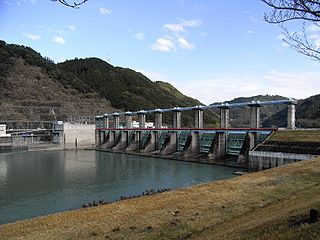
The Funagira Dam is a dam on the Tenryū River, located in Tenryū district, Hamamatsu city, Shizuoka Prefecture on the island of Honshū, Japan.

The Shiogō Dam is a dam on the main stream of the Ōi River, in the town of Kawanehon, Haibara District, Shizuoka Prefecture on the island of Honshū, Japan.
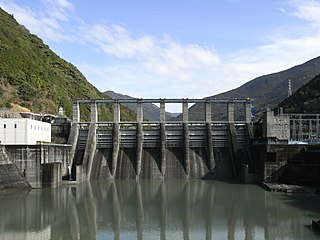
The Akiba Dam is a dam on the Tenryū River, located in Tenryū-ku, Hamamatsu, Shizuoka Prefecture on the island of Honshū, Japan.

The Miyagase Dam is a dam on the Nakatsu River, a main tributary of the Sagami River in Aikō District, Kanagawa Prefecture, Japan. It straddles the border between the village of Kiyokawa, town of Aikawa and the former town of Tsukui.


